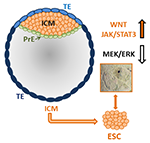Factors necessary to secure stem cell stability
Pluripotency maintenence
DOI:
https://doi.org/10.18388/pb.2021_415Abstract
Obtaining stable embryonic stem cells (ESC) from animals and humans opens up a wide spectrum of opportunities for science and regenerative medicine. The basic procedures necessary to obtain ESC are universal for all mammalian species. The challenge is to maintain species specific conditions required to support pluripotency characteristic for the pre-implantation embryo. To date, true ESC lines (stable in culture, pluripotent with high differentiation potential) have been obtained only for a limited number of species such as, mice, human and rats. The main obstacles arise from species specific differences, and thus different environmental requirements. However, in all cases, it is essential to maintain the activity of pluripotency related signalling pathways (WNT, MAPK/ERK and JAK/STAT3). The classical system dedicated to obtain mouse and human ESCs dependant on LIF (mice) of FGF (human) is not optimal. Currently, ESC derivation systems are based on chemical inhibitors that have the ability to interact with the above-mentioned pathways. This manuscript introduces the key factors important for understanding the nature of various types of stem cells (not only those of embryonic origin), and explains why there is no one way to obtain pluripotency, and why the definition of a stem cell is not universal.

Published
Issue
Section
License
Copyright (c) 2022 Advances in Biochemistry

This work is licensed under a Creative Commons Attribution 4.0 International License.
All journal contents are distributed under the Creative Commons Attribution-ShareAlike 4.0 International (CC BY-SA 4.0) license. Everybody may use the content following terms: Attribution — You must give appropriate credit, provide a link to the license, and indicate if changes were made, ShareAlike — If you remix, transform, or build upon the material, you must distribute your contributions under the same license as the original. There are no additional restrictions — You may not apply legal terms or technological measures that legally restrict others from doing anything the license permits.
Copyright for all published papers © stays with the authors.
Copyright for the journal: © Polish Biochemical Society.



